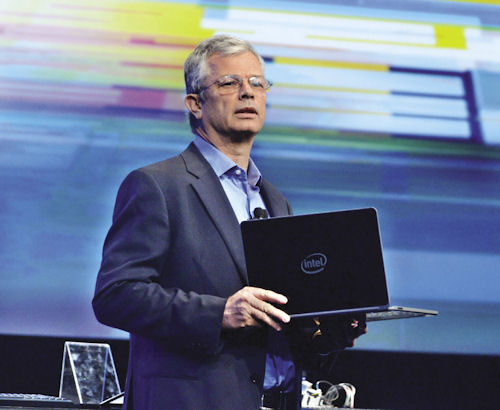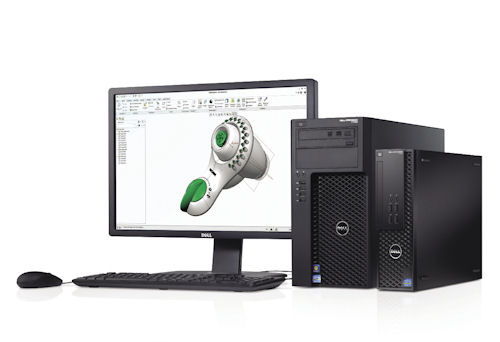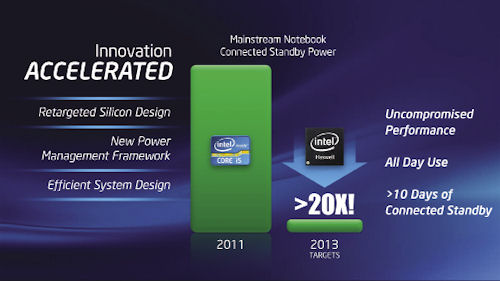Change Brewing in the Computer Power Game
Intel Haswell's promise of lower power and longer battery life prompts new views on HPC and professional workstations.
Latest News
June 1, 2013
| Update: Haswell Officially Debuts |
At press time (mid-May), Intel Haswell was still a month away from its scheduled public release. Haswell is, in fact, just a codename, not an official brand. The product is the fourth-generation Intel Core architecture, a successor to the third generation Ivy Bridge. Processors built on Haswell are expected to first appear in Intel’s consumer product line (branded Core i). Following Intel tradition, the same architecture is also expected to spawn processors for the professional workstation and server markets.
 At Intel Developer Forum 2012, Dadi Perlmutter, executive vice president and general manager of Intel architecture group, showcases a lightweight notebook as he discusses fourth-generation Intel Core architecture’s low power consumption and longer battery life. |
The details of Haswell reported in the media have come primarily from presentations at the Intel Developer Forum during the past two years. Keynotes from the International Consumer Electronics Show (CES) and other events have shed more light on Intel’s plan.
Taking the stage at Intel Developer Forum 2011 in San Francisco, Intel CEO and president Paul Otellini shared the company’s processor roadmap.
“Haswell was designed to enable a 30% (improvement) in connected standby power over the currently shipping notebooks using our second-generation Core microprocessors,” he said. “We’ve targeted Haswell’s design not just for lower power, but for architecting a system-level power management framework that ... has the opportunity to reduce the platform power by a factor of more than 20 over our current design. We’ll do and deliver all of this without compromising any of the performance you’ve come to expect from today’s mainstream notebooks.”
Haswell’s design could lead to more than 10 days of connected standby battery life for lightweight, portable devices, according to Intel: “The advancements will aid in delivery of always-on-always-connected computing where Ultrabooks stay connected when in standby mode, keeping the e-mail, social media and digital content up-to-date” (“Intel CEO Outlines Company’s Plans to Lead Future of Computing,” Sept. 13, 2011, Newsroom.intel.com).
In a consumer market dominated by tablets, smartphones and lightweight notebooks, Haswell’s promise of low power and longer battery life is music to buyers’ ears. But the anticipation is also spilling into professional workstation and high-performance computing (HPC) markets, as original equipment manufacturers (OEMs) begin contemplating Haswell-integrated systems and servers.
A Thin, Cloudy Future
Intel is betting heavily on the Ultrabook—a thinner, lighter type of subnotebook—as the future of day-to-day computing. The company has, in fact, trademarked “Ultrabook” as its brand. Haswell’s architecture is expected to be the driving engine behind this slim-computing vision.
At Intel Developer Forum 2012, Dadi Perlmutter, executive vice president and general manager of the Intel architecture group, demonstrated a working prototype of Haswell by comparing the performances of two Ultrabooks: one running on present-day Ivy Bridge architecture, the other on Haswell.
 The Dell Precision T1700 is available as a small-form factor (far right) or mini tower workstation, both of which can be ordered with the new Haswell 4th Generation Intel Core or Xeon processor E3-1200 v3 product family. |
“The great thing about this one ]Haswell]—it was designed with mobility in mind,” he said. “As the world moves to more and more mobility, I’ve been challenging the team to go figure out how to fit Haswell into something like this,” he added, as he held up an ultra-slim notebook.
This January at CES, Kirk Skaugen, Intel’s corporate vice president and general manager, PC Client Group, showcased a concept laptop called Northgate—a standalone tablet with a detachable dock—running on Haswell processors. “Haswell is the first product to develop with the Ultrabook in mind,” noted Skaugen. “The other ones were things we had to retrofit.”
The same Haswell technology is also destined to appear in the Intel Xeon E3 processors, according to reports emerging from Intel Developer Forum in Beijing. Xeon E3 targets the low-cost server market. Such clusters, especially when augmented with power efficiency, could be attractive solutions for vendors offering cloud-hosted solutions.
Because of their memory bandwidth and comparatively low CPU frequencies, current mobile tablets in the market are not considered ideal for running CPU-intensive design and engineering programs (for example, CAD, simulation and rendering software). However, Haswell’s mobile-ready architecture could lead to the development of tablets with sufficient power to facilitate professional design operations now performed on desktop workstations.
OEMs Planning Ahead
Tim Lawrence, BOXX Technologies’ vice president of engineering, observes that “Haswell is a good fit for some areas in the professional workstation market. There are many professional applications that cannot use more than a few CPU cores, and are therefore very dependent on CPU frequency and individual core performance. Regarding these applications, BOXX foresees Haswell as a significant platform for our entry-level through XTREME performance tiers.”
BOXX is planning to offer Haswell-powered mobile workstations, desktops and overclocked workstations under its BOXX XTREME brand.
Dell recently announced its new Haswell-based workstation, the Precision T1700, which it calls the smallest and lightest workstation in its class.
Eliot Eshelman, Microway’s senior technical account manager, notes that “Haswell will be the foundation for the majority of our products once the server chips are released. Haswell will be in our high-performance WhisperStations and traditional HPC compute clusters.”
Even though Haswell’s launch was still six weeks way when he spoke to DE, Tau Leng, vice president of corporate marketing and HPC at Supermicro, reveals that “We have over 50 solutions optimized for Haswell ready to ship.” The advance preparation is partly to allow Supermicro’s partners to develop and validate their solutions for maximum compatibility and performance.
“Haswell’s lower power 3D transistor technology delivers more cores, better memory performance and higher efficiency,” Leng says. “In some applications, we’ve seen more than a 30% gain in performance and power efficiency when combined with our overall system architecture.”
David Okada, senior marketing manager for Supermicro, highlights the company’s 3U (8, 12 or 24 node) MicroCloud as a unique platform optimized for Haswell.
“MicroCloud maximizes the advantages of low-power processor technologies with high-density integration in a cooling zone-optimized, easily serviceable modular design,” he adds. “Haswell-based MicroCloud systems will offer enhanced performance, and even more cost-effective utilization of space and power with support for the full range of Intel Xeon E3-1200 v3 processors as they become available.”
At CES, Intel’s Skaugen revealed some Haswell processors could run on as low as 7 watts. BOXX’s Lawrence says his firm foresees “a significant power advantage” with Haswell. BOXX is among the few suppliers offering overclocked systems. Overclocking allows the system to run the processor at a faster speed than manufacturer-specified speed, but it requires careful balancing of the thermal output and performance gain. Power-efficient Haswell processors are expected to give BOXX more possibilities for overclocking.
Individual Haswell processors may use less power, but Microway’s Eshelman cautions that might not be the case with all clusters built with Haswell processors.
“For those who are concerned with the overall heat generation and power consumption, I’m sure Intel has low-power variants ]of Haswell server products],” Eshelman says. “But the highest-performing options, I’m guessing, will take a few more watts.”
When calculated in performance gain per watt, the newer Haswell processors will prove to be a better bargain, he adds. Either way, power is a negligible factor for his customer base: “Our customers regularly use 115W, 135W and sometimes even 150W chips. Except in the largest clusters, they’re not going to quibble about 10 more watts.”
For Graphics-hungry Users
Intel’s Ivy Bridge processors come with HD4000 graphics. Haswell-generation Xeon E3 products are also expected to contain integrated graphics and video functions.
“The progress that Intel has made with processor graphics is nothing short of phenomenal,” says Wes Shimanek, Intel’s workstation segment manager. “I’d say 50% of the people who work in basic CAD and 3D would be more than happy with the results from processors shipping now. Intel continues to dedicate additional silicon toward the graphics. In next-generation Haswell processors, integrated graphics will have more execution units. So you’ll see a substantial increase in performance in rendering graphics.” (Author’s Note: Execution units are part of the processor performing computing operations; they are not the same as computing cores.)
The additional execution units, combined with new instruction sets, are expected to deliver better performance in engineering software programs like Autodesk Inventor, Dassault Systemes’ SolidWorks, Siemens PLM Software’s NX and Solid Edge, PTC Creo, and others.
Integrated graphics is also Intel’s countermeasure against NVIDIA’s graphics accelerator hardware. The tight competition for consumer’s pocketbooks put the CPU and GPU at loggerheads. Both want to convince the consumer that their hardware offers greater bang for the buyer’s bucks.
If, after satisfying the basic performance needs, a consumer is still left with disposable income, NVIDIA would persuade the buyer to invest in a professional graphics card to boost visualization and parallel-processing capacity. Intel’s Shimanek has a different suggestion.
“I work for Intel, so I’d love it if the consumer buys the top-end professor ]with the highest frequency available in the market], but you can also buy about two frequencies down ]for example, 2.8GHz instead of 3GHz], then invest the money you saved in buying twice the amount of memory equals to the highest model size you’ll be working with,” he says. “If you do that, you’ll likely get twice the performance.”
In Shimanek’s reasoning, while users can always benefit from faster frequencies, he believes that a balanced computing solution can actually help users achieve a better overall experience.
“Save a little on frequency and increase your memory; save a little on graphics and invest in solid state drives,” he says. “When you do that, you can actually impact a broader array of applications that users employ in the day in the life of an engineer.”
Microway’s Eshelman thinks there’s something else in Haswell that’s much more attractive than graphics to his customers. The new fused multiply-add (FMA) instruction set in Haswell, Eshelman notes, is particularly useful to those engaging in scientific applications.
“I’ve already had a scientist here and there asking for access to early Haswell silicon to test the speedups,” he says.
Untouched by Multitouch
When demonstrating Haswell at CES, Intel’s Skaugen explains that fourth-generation Ultrabooks will have a “mandatory touch requirement.”
With such a requirement, Intel is not just laying the foundation but actively championing a new kind of computing experience—one that incorporates touch, voice, facial recognition and gesture-based interactions. So far, touch remains a touchy subject in the professional market. Would you, for example, forsake your mouse and keyboard to draft in AutoCAD or model in CATIA using fingertips? Maybe there’s a market for that among the iPad generation, but many OEMs aren’t willing to gamble on it, yet.
 From Intel CEO and President Paul Otellini’s presentation at Intel Developer Forum 2011, comparing Intel Core i5 to Haswell’s anticipated performance. |
BOXX’s Lawrence reports that he hasn’t seen a high demand for touch-enabled systems among his customers, although he adds that “touch is great for consuming the result after it has been created on a workstation.”
Microway’s Eshelman has had similar feedback. “We have not had one customer ask for a professional workstation with touchscreen,” he says. “It may happen eventually, but none of the engineers I’ve spoken with are enthusiastic about such a change.”
On the other hand, software makers like Autodesk, Dassault Systemes, PTC and Siemens PLM Software have ventured into mobile devices by releasing robust mobile apps that offer viewing and markup functions, along with basic drafting tools. In the case of Autodesk’s AutoCAD WS, the tablet-friendly, cloud-powered app is more than a viewer; it’s meant as a drafting program to create and edit complex 2D plans from scratch.
The Power Grab
Intel Haswell’s tablet-friendly, low-power architecture is a good strategy to counter the recent advances made by GPU maker NVIDIA with its Tegra product line. At CES, while Intel hailed its new Haswell architecture, GPU maker NVIDIA was also introducing Tegra 4, its next-generation chip for smartphones and tablets. The latest quad-core Tegra integrates ARM processor cores, found in iPhone models.
As traditional desktops face unprecedented threats from mobile devices, hardware makers’ competition for market share in the mobile market grows fierce. The next milestone for Intel, NVIDIA and their rivals is to offer supercomputing performance in the space and power envelope of mobile computers. Intel Haswell is a notable marker in that long-distance race.
Kenneth Wong is Desktop Engineering’s resident blogger and senior editor. Email him at [email protected] or share your thoughts on this article at deskeng.com/facebook.
More Information
Subscribe to our FREE magazine, FREE email newsletters or both!
Latest News
About the Author
Kenneth Wong is Digital Engineering’s resident blogger and senior editor. Email him at [email protected] or share your thoughts on this article at digitaleng.news/facebook.
Follow DE





